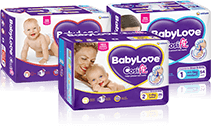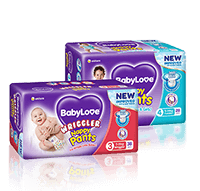Nappy Rash, Urine & Stool
To prevent nappy rash from happening, parents are advised to use nappies that have high absorbency power and that stay dry and breathable at all times while also giving the baby enough care and comfort.
1. Nappy Rash
In general nappy rash can be identified through these following symptoms:
Skin symptom:
The nappy regions (baby’s buttocks, thighs and genitals) are marked with red, puffy and tender skin indicating nappy rash.
Changes in your baby’s disposition:
Your Baby seems uncomfortable, fussy and cries when changing nappy or when the nappy region is being cleaned or touched.
Contributing factors that could lead to nappy rash & ways of preventing it.
| No. | Contributing Factors | Prevention Methods |
| 1. | Prolonged exposure to urine and stool. | Frequent change of nappies and / or use of nappies with strong absorbency power such as BabyLove Nappies. |
| 2. | Chafing or Rubbing (Nappies that are too tight or clothing that rubs against your baby’s skin can cause rashes). |
Use BabyLove Nappies with superb comfort and breathability that gives your baby a comfortable fit and protection for a happier and healthier baby. |
| 3. | Reaction to new / various food. | Introducing solid food to your baby might change their stool texture, be wary and try to avoid food that could upset your baby’s stomach. |
| 4. | Changes in your baby’s diet. | Changes in your baby’s diet might also increase the frequency of passing stool and lead to nappy rash. |
| 5. | Intolerance or allergy to food. | Avoid food that may cause intolerance or allergy such as milk, wheat, soy, etc. |
| 6. | Reaction to baby products such as disposable wipes, baby lotions, powders or oils. | Be mindful and have a watchful eye on type of products that might irritate your baby’s skin. |
| 7. | Use of detergents, bleaches or fabric softener that irritates your baby’s skin. | Be mindful and have a watchful eye on type of products that might irritate your baby’s skin. |
| 8. | Sensitive baby skin that suffers from skin conditions such as eczema. Be sure to apply the right medication to help ease and improve your baby’s skin condition. | |
| 9. | Use of antibiotics that could rid your baby’s body of good bacteria that prevent yeast infections. |
Extra precautionary and prevention methods to further prevent your baby from developing rashes:
| No. | Prevention Steps | Results |
| 1. | Wash hands | Prevent spreading of bacteria or yeast when changing nappy. |
| 2. | Frequently change nappy. Rinse baby’s bottom during each nappy change. Gently pat dry. Avoid baby wipes. Use running water where possible. |
A clean baby’s bottom prevents irritation and bacteria built-up that could cause rashes. |
| 3. | Pat baby’s bottom rather than scrubbing. | Scrubbing could irritate the skin, and the use of clean towels could further prevent bacteria spread. |
| 4. | Avoid plastic pants. | Plastic pants trap moisture and heat at the nappy region. |
| 5. | Occasionally leave your baby’s bottom uncovered. | Exposing your baby’s skin to air will promote a healthier skin. |
| 6. | Regular use of protective cream after nappy changes. Apply thickly. Talcum powders are not recommended. | The use of ointments such as petroleum jelly and zinc oxide during nappy change can help prevent skin irritation. |
| 7. | Increase your baby’s fluid intake. | High fluid intake may reduce the urine’s concentration thus making it less irritating. |
Note:
Seek medical advice if:
- Rash not improved after 3-4 days of treatment
- Blisters, crusts, pimples appear
- Child is upset with nappy changes and sleeping poorly as a result
- Unexplained fever
- Rash worsening and spreading
- Penis tip is red and swollen
2. Baby’s Urine
A baby’s urine can become a barometer for their growth and health. As your baby grows, the volume of the urine will increase while the frequency decreases. Its colour and smell can also indicate your baby’s health status as follows:
Urine Chart
| Colour | Smell | Reason / Cause | Status |
| Pale lemon or straw or no colour | No smell or smell of ammonia | Breastfed babies’ urine tends to have no colour or smell, but when the weather is hot and baby sweats a lot the urine will be slightly darker. | Normal & healthy baby |
| Hot brick or tea or darker | Stronger smell of ammonia |
|
Child may be dehydrated and not feeding enough. Seek medical attention. |
| Pinkish, Red or Brown | Really smelly or brown sugar or maple syrup smell | Could be due to many reasons but normally due to small amount of blood in urine. | Seek medical attention immediately. |
Stool Chart
The same method applies to a baby’s stool that can become a barometer for your baby’s growth and health by identifying its texture and colour as below:
| Colour | Texture | Sizes & Smell | Reason & Cause | Status | |
| Breastfed Babies (Newborn) | Dark green/black (first Stool) Mustard or earthy or greenish |
Soft & seedy (Unformed) Can be runny | Small stools (8-10 stools/day) Smells quite sweet Less frequent, but still soft after a few months |
Emission of meconium that layers baby’s gut. | Healthy |
| Formula Fed Babies (Newborn) | Shades of Brown Grey-yellow Grey-blue Can vary a lot in colour |
Firmer (pudding thick) more formed Can vary a lot in consistency |
Larger & smellier stools | Different formulas give different texture and colour to baby’s stool. | Healthy |
| Babies at any age in general | Reddish or black | Soft – softly formed | Tinge of blood might be present due to:
|
Seek Medical Attention. | |
| Green | Mucous-like | Virus infection (possible cause) will run for a few days and heal naturally. | Seek medical attention. | ||
In general your baby’s stool colour and texture will vary according to the type of food your baby eats. The older your baby grows and change of food intake from liquid to soft food, and to solid food will affect the stool produced. It is wise to monitor your baby on a regular basis and relate any other physical changes such as frequent crying, loss of weight, inactivity and other symptoms that might indicate sickness.




